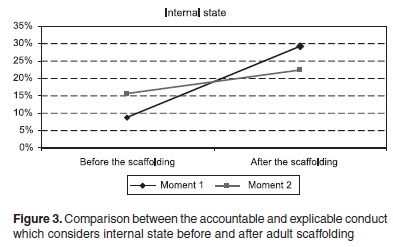PURPOSE: To verify the oral narrative abilities in preschoolers, before and after language stimulation. METHODS: Participants were 58 preschoolers. The study was developed in three stages: 1. Pre-stimulation stage (Moment 1) - preschoolers produced the first autonomous narrative based on a sequence of pictures, and the second under adult scaffolding; 2. Stimulation stage - it was conducted a weekly reading of children's stories in group, for ten weeks; 3. Post-stimulation stage (Moment 2): the same procedure of the first stage was repeated. The results analysis considered: the occurrence of central and secondary events; the accountable/explicable conduct, classified according to physical causes, moral/social rules and internal state; the attribution and rectification of false beliefs, analyzed by the internal state's accountable/explicable conduct. RESULTS: There was an increase in the occurrence of central events in Moment 2 as well as after the adult scaffolding, with decrease of secondary events comparing both moments and after the scaffolding. Regarding the accountable/explicable conduct, no differences were found between physical, social/moral rules, and internal state conducts. The internal state accountable/explicable conduct was predominantly found in all the autonomous narratives. CONCLUSION: Both the reading of children's stories and the adult scaffolding contribute to the increase in the occurrence of events in autonomous narratives. There is no variation on the type of accountable/explicable conduct in the narratives. The internal state accountable/explicable conduct is predominantly used by preschoolers.
Child, preschool; Narration; Child development; Child language; Theory of mind; Verbal behavior





